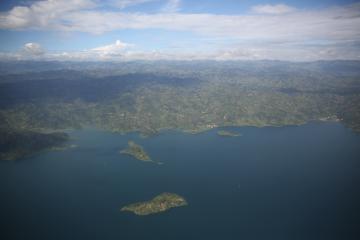
The Congo Basin Impact Programme, funded by the Global Environment Facility (GEF), is about protecting and enhancing the sustainable planning and management of the transboundary land use of this ecoregion, which covers a total of more than 1.7 million square kilometres, and is the second largest tropical rainforest on earth. The programme countries include the Democratic Republic of the Congo (DRC), Cameroon, Central African Republic, Equatorial Guinea, Gabon and the Republic of Congo (RoC).
To this aim, UNEP, together with the GEF and its partners, met in Kinshasa, DR Congo, on 31 May and 1 June 2022 to launch the GEF - Congo Basin Impact Programme. The workshop was attended by GEF government focal points, UNEP as the GEF implementing agency, GEF Executing Agencies, technical partners, and civil society to discuss roles and responsibilities as well as linkages and synergies between project constituents and project countries.
"Preserving intact tropical forest landscapes is the cheapest solution in the double crisis we are currently facing - the biodiversity crisis and the climate crisis," says Jean-Marc Sinnassamy, GEF's Senior Environmental Specialist at the programme launch in Kinshasa. The Congo Basin, with its recently discovered world's largest tropical peatland, has a unique biodiversity with a high degree of endemism. More than 400 mammal species, 1,000 bird species and over 10,000 plant species are found in the basin. Three of the four great apes live in the forests: Gorillas, chimpanzees and bonobos, as well as the endangered forest elephants and bongo antelopes.
The recent discovery of the world’s largest tropical peatland in Congo Basin has revealed to the world the importance of this eco-region as one of the world's most climate-relevant hotspots. These recently discovered tropical peatlands, constituted of layer upon layer of peat has been stored for 10,000 years, hermetically sealed dead plant materials stored down to a depth of six meters, sequester an estimated 30 billion tons of carbon. This makes the Congo Basin one of the largest carbon sinks on earth.
Without adequate protection under enhanced sustainable land use planning and managing of the Congo Basin, habitat loss may cause the endemic biodiversity to go extinct in the near future.
But it is not just a question of the loss of biodiversity. Illegal logging still threatens the Congo Basin. Illegal hunting and wildlife trafficking are widespread. Agricultural land is expanding rapidly. Mining, massive oil extraction plans and the associated infrastructure development have emerged as serious new threats to this world’s largest tropical peatlands, and are challenging and impeding the Congo Basin’s capability as a world climate relevant hotspot. Recent data from an ongoing study by researchers at the University of Ghent, shows that the Congo Basin rainforest absorbs more carbon than the Amazon rainforest, making it the most important “lung” of our planet. If the peat bog were to be exploited, drained, or burned, for example to build roads, plantations or even to extract oil, the carbon stored there would escape into the atmosphere as carbon dioxide (CO2) and dinitrogen oxide (N2O). The effect would be so enormous that it would be equivalent to three years of global fossil fuel emissions.
“The Congo Basin Impact Programme aims to prevent exactly this - while there is still time”, says Jean-Marc Sinnassamy of the GEF. In the future, sustainable forest management will be supported through transboundary land use planning, and the most valuable parts of the rainforest, its biodiversity, and the globally unique peatlands will be protected. UNEP, together with the GEF and its partners, will provide solutions and deliver frameworks for conservation and sustainable land use. They will involve and empower local and indigenous people and engage the private sector in nature conservation.
“This is the most effective way to ensure that the Congo Basin does not get degraded and remains intact in the long term” says Sinnassamy. "Protecting what we can preserve today is imperative, rather than having to restore it later at great expenses and efforts or, in the worst case, running the risk of losing peatland and rainforest forever“.
A wise man one wrote “it is easier to build strong children than to repair broken [wo]men”, and the same principle applies to our ecosystems.
